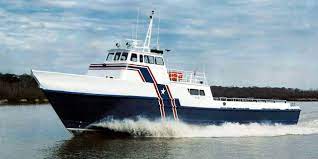The Future of Sustainable Shipbuilding: How Marine Ship Manufacturing is Embracing Green Technology
As the world focuses more on environmental sustainability, the marine ship manufacturing industry is undergoing a transformation. With increasing pressure to reduce emissions and limit environmental damage, shipbuilders are adopting green technologies and practices. This article explores the strides marine ship manufacturers are making toward sustainability, the challenges they face, and the future of green shipbuilding.
1. The Need for Sustainability in Marine Ship Manufacturing
The global shipping industry contributes significantly to greenhouse gas emissions, accounting for nearly 3% of the world’s total emissions. This has spurred regulatory bodies like the International Maritime Organization (IMO) to impose stricter environmental regulations on shipbuilders. Marine ship manufacturers are now tasked with creating vessels that not only meet international safety and performance standards but also reduce their environmental impact.
Key Drivers for Sustainability:
- IMO Regulations: The IMO has set ambitious targets to reduce CO2 emissions from ships by at least 50% by 2050.
- Environmental Awareness: Growing environmental consciousness among consumers and businesses has led to a demand for greener ships.
- Economic Efficiency: Sustainable ships consume less fuel, leading to long-term savings in operational costs.
2. Green Technologies Transforming Shipbuilding
Marine ship manufacturers are implementing various green technologies to meet environmental goals. These technologies are helping to reduce emissions, improve energy efficiency, and minimize waste.
Hybrid and Electric Propulsion Systems
Many shipbuilders are exploring hybrid and electric propulsion systems as alternatives to traditional diesel engines. These systems not only reduce CO2 emissions but also cut down on noise pollution, making them ideal for both commercial and passenger vessels.
LNG (Liquefied Natural Gas) as a Fuel Alternative
LNG is gaining popularity as a cleaner fuel option for ships. It produces fewer sulfur oxides (SOx) and nitrogen oxides (NOx) compared to conventional fuels, helping ship manufacturers comply with emissions regulations.
Wind-Assisted Propulsion
Several shipbuilders are experimenting with wind-assisted propulsion systems, such as installing large sails or kites on cargo vessels. These systems harness wind energy to supplement engine power, leading to fuel savings and reduced emissions.
Hull Optimization and Energy-Efficient Designs
Streamlined hull designs and energy-efficient ship structures minimize water resistance and reduce fuel consumption. Advanced simulation software helps manufacturers test and perfect these designs before they are implemented.
Onboard Waste Management Systems
Modern ships are being equipped with sophisticated waste management systems to handle and recycle waste products more effectively. This reduces the impact of shipping operations on marine ecosystems.
3. The Challenges of Green Shipbuilding
Despite the push for sustainability, the marine ship manufacturing industry faces several challenges in adopting green technologies.
High Initial Costs
Building eco-friendly ships requires significant upfront investment in new technologies, materials, and designs. While the long-term savings are evident, many shipowners and manufacturers are hesitant due to the high initial costs of implementation.
Technological Limitations
While advancements in green technologies are promising, some solutions—such as fully electric ships for long-distance travel—are still in their infancy. Battery capacity, charging infrastructure, and range limitations pose significant hurdles.
Global Standardization
With different countries and regions imposing their own environmental regulations, it can be difficult for shipbuilders to create vessels that meet all the varying standards. Standardization across global regulations would make it easier for ship manufacturers to comply.
4. The Future of Sustainable Shipbuilding
The future of marine ship manufacturing lies in creating vessels that are more energy-efficient, environmentally friendly, and technologically advanced. Here are a few trends that are expected to shape the industry in the coming years:
Autonomous and Smart Ships
Autonomous ships equipped with artificial intelligence and machine learning are expected to become a key feature in sustainable shipping. These ships will optimize their routes, monitor fuel consumption, and avoid environmentally sensitive areas, reducing their impact on the environment.
Hydrogen-Powered Ships
Hydrogen fuel cells hold great potential as an alternative energy source for ships. They produce zero emissions, with water being the only byproduct. Several prototypes of hydrogen-powered vessels are already in development, and their widespread adoption could revolutionize the industry.
Circular Shipbuilding
Circular shipbuilding focuses on designing ships with recyclable materials and modular components that can be easily repaired or replaced. This approach minimizes waste and reduces the environmental footprint of ship manufacturing over a vessel’s lifespan.
Carbon-Neutral Shipyards
Marine ship manufacturers are also working towards making their production processes carbon-neutral. From using renewable energy sources in shipyards to incorporating sustainable materials into construction, the shipbuilding process itself is becoming greener.
5. Case Study: HILLROM’s Commitment to Sustainability
HILLROM Marine Ship Manufacturing Industries has emerged as a leader in sustainable shipbuilding. By investing in green technologies and adopting innovative design practices, HILLROM is building ships that meet both current and future environmental standards.
Eco-Friendly Initiatives:
- Energy-Efficient Ship Designs: HILLROM utilizes cutting-edge design software to create fuel-efficient hulls that reduce energy consumption.
- Hybrid Vessels: The company has developed hybrid ships that use a combination of diesel and electric propulsion systems, significantly cutting emissions.
- Green Shipyard Operations: HILLROM’s shipyards operate using renewable energy, and their waste management systems ensure that production processes are as eco-friendly as possible.
Conclusion
As environmental regulations tighten and global awareness of sustainability grows, the marine ship manufacturing industry is at a critical juncture. Shipbuilders must adopt green technologies and embrace innovative practices to meet the demands of a cleaner, more sustainable future. Companies like HILLROM are leading the way, showing that it is possible to build efficient, high-performing vessels while minimizing the environmental impact. The future of the marine ship manufacturing industry lies in sustainability, and the industry’s continued innovation is key to ensuring a greener world.

